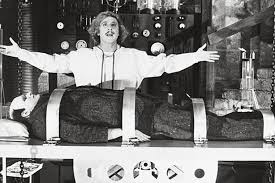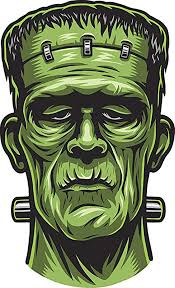On the birthday of Mary Wollstonecraft Shelley (Aug 30), I cannot help but remember her most popular creation Victor Frankenstein. An extremely ambitious scientist who aspired to create human life out of corpses, Frankenstein reminds us what can be the repercussion to our overtly high aspirations. At a time when all of us are witnessing the seemingly never-ending nightmarish COVID-19 pandemic, Frankenstein’s monster makes us contemplate what disastrous consequences the advancement of science can lead to. Human race was ambitious, just like Frankenstein. And the pandemic has even fuelled discussions focusing on a far-fetched result of that greed for acquiring everything.
Most of the readers might have had some acquaintance with Frankenstein and his monster in some form – ghastly or comic! Since the book was published on 1818, it has been adapted at least 72 times not only on the silver screen, television, stage, comic books but its manifestation can also be witnessed in music and games. So, what is it in this character that it has assumed so many dimensions and colours over the years?

Let us go back to the history of its conception. Frankenstein was born out of the nib of Mary Shelley while she was on a trip to Geneva to meet poet Lord Byron with her to-be husband poet Percy Bysshe Shelley in the summer of 1818. It was an unusually cold and dreary summer that year and both the Shelleys, Byron and his friend John Polidori decided to write spooky stories to match the environment. Blessed with the genetic constitution of political philosopher William Godwin and feminist Mary Wollstonecraft, Mary Shelley created an unprecedented and remarkable Gothic story. And, thus, Frankenstein was born. At 20, Mary became a sensation.
Since his birth, there have been many rebirths of Frankenstein. In a film adaptation (Young Frankenstein, 1974) by Mel Brooks, there is a dialogue: “All them scientists -they’re all alike (sic). They say they’re working for us but what they really want is to rule the world!” Maybe, it is that mad ambition of scientist Victor Frankenstein that has survived all these years. If the question ‘man made God or God made man’ lies in the subconscious of many people, the birth of the monster gave rise to curiosity if man could be the creator of the human race like God. In a book like Frankenstein, the answer was – yes! When Frankenstein realizes he is about to create life, he is ecstatic! In a letter to his lover Elizabeth, he writes:
“Sweetheart,
Tonight my ambition will be accomplished. I have discovered the secret of life and death and in a few hours I shall create into life the most perfect human being that the world has yet known. When this marvelous work is accomplished I shall then return to claim you for my bride.
Yours devoted,
Frankenstein.”
Sadly, Frankenstein could not literally create a human; rather, he creates a monster. And the cost he pays for his creation is quite heavy. The monster wreaks havoc: he kills Frankenstein’s brother William, his wife Elizabeth and his friend Henry Clerval. He drives his creator so crazy that he ultimately dies with remorse.

In the film adaptation titled ‘Frankenstein’ (1957) by Herbert L. Strock, the protagonist says: “What I create, I must control.” It is perhaps this misconception that Frankenstein has before he decides to create life. He thinks the new creature created by him will be a slave to his whims. Shockingly, the monster assumes a different form the moment it is created. In Frankenstein’s monster lies a greater truth that perhaps people are able to relate to – that parents cannot control their children, no matter how hard they try. They expect their children to be everything that they want to but, ultimately, they grow up to be different human beings with their own aspirations. The popularity of Frankenstein is perhaps because of his helplessness that has become so relatable over the ages. The COVID-19 pandemic also reminds us about this helplessness. Human beings cannot control a virus despite taking control of so many other things in the world. They might have brought their own peril, though unknowingly.
Of the 72 adaptations of Frankenstein, 43 have the word ‘Frankenstein’ in their titles. Perhaps the most well-known adaptation is James Whale’s ‘Frankenstein’ (1931). Whale’s stiff-faced, square-jawed monster with broad shoulders (played by Boris Karloff) automatically comes to our mind whenever we try to imagine Frankenstein’s creation. Other notable adaptations are Thomas Edison’s ‘Frankenstein’ (1910), Kenneth Branagh’s ‘Frankenstein’ (1994), Herbert L. Strock’s ‘Frankenstein’ (1957), Max Landis’ ‘Frankenstein’ (2015), Paul Morrissey’s ‘Flesh for Frankenstein’(1973), James Whale’s sequel ‘Bride of Frankenstein’ (1935), Stuart Beetle’s ‘I, Frankenstein’ (2014), Charles Barton’s ‘Abbott and Costello Meet Frankenstein’ (1948) and Mel Brooks’ ‘Young Frankenstein’ (1974). Some of these adaptations are loosely based on the story of Mary Shelley and some are parodies. Thomas Edison’s ‘Frankenstein’ is a monochrome silent film and perhaps the earliest adaptation. Like the book, this film presumably pioneered the science fiction genre.
At least five cartoon films, namely, Mickey’s ‘Gala Premier’ (1933), ‘Hollywood Capers’ (1935), ‘Have you got any castles?’ (1938), ‘Franken-Stymied’ (1961) and ‘Dr. Devil and Mr. Hare’ (1964), are based on Frankenstein. The latest adaptation is perhaps ‘Frankenstein’s Monster’s Monster, Frankenstein’ (2019) – a half an hour comedy on Netflix.


